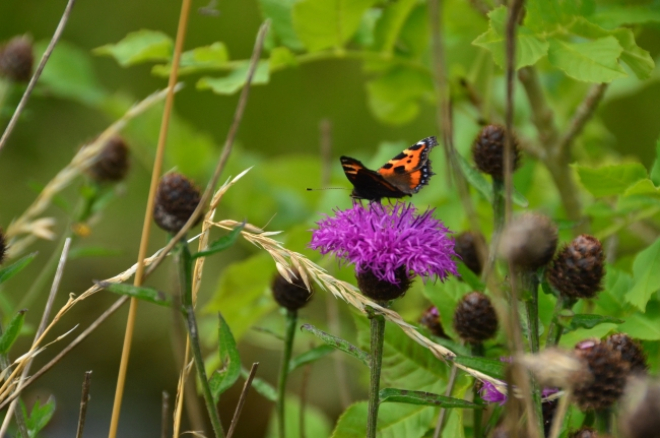Species on the Edge Launched

Eight leading conservation organisations have launched an innovative new multi-species conservation programme, Species on the Edge, focussed on reversing the decline of vulnerable coastal species in Scotland.
Species on the Edge is a new bold and ambitious partnership programme of NatureScot and seven nature conservation charities, all dedicated to improving the fortunes of 37 priority species found along Scotland's coast and islands. The programme celebrated its official launch today (June 3) with a free and open-to-all launch event at Logie Quarry near Tain. The launch event was organised by Butterfly Conservation, which are leading Species on the Edge on the East Coast, and hosted by Balnagown Estate, which own the site.
With £4 million funding from the National Lottery Heritage Fund, and an overall programme cost of over £6.5 million, the Species on the Edge partnership will deliver a four-and-a-half-year programme of work to tackle the impacts of environmental change on wildlife, benefiting both nature and people. Together the eight partners are combining their collective expertise to tackle species decline across seven landscape areas in Scotland: the Outer Hebrides; the Inner Hebrides, Argyll and Lochaber; the East Coast; the North Coast; Orkney; the Solway coast; and Shetland.
The Species on the Edge partners are Amphibian and Reptile Conservation, The Bat Conservation Trust, Buglife, Bumblebee Conservation Trust, Butterfly Conservation, NatureScot, Plantlife and RSPB Scotland.
Scotland’s coast and islands are amongst the most biodiverse areas in the UK. They provide a last refuge for some of our most beautiful and unusual, but also most vulnerable, species. Many are in decline and some are on the cusp of extinction.
The State of Nature Scotland 2019 reported a decline in 49% of Scotland’s species since 1970, with 91 species critically endangered. Habitat loss, climate change, pollution, invasive species, disease, and changes to land management practice are key drivers of biodiversity decline.
While human activities have contributed to the rates of biodiversity decline, people are also at the heart of reversing this decline. Working with local communities, Species on the Edge aims to:
• secure and improve the future for coastal and island species in Scotland
• form a support network between communities, to safeguard vulnerable biodiversity
• strengthen the partnership approach to conservation work in Scotland
• raise awareness of the importance of biodiversity to Scotland.
Programme activity will include species survey and monitoring, habitat creation and restoration, education and learning events, advice for land managers, volunteering opportunities, training workshops, traineeships, work experience and more.
Species on the Edge’s priority species include amphibians, birds, bats, plants, butterflies, bumblebees and a number of other invertebrates. The launch event will focus on the Small Blue butterfly – one of the project’s priority species in the East Coast area which breeds at Logie Quarry.
Nick Halfhide, NatureScot’s Director of Nature and Climate Change, said: “It’s fantastic to see Species on the Edge launching. It is an excellent example of what can be achieved through working in partnership and, in the face of the biodiversity crisis, will help us to maximise efforts to secure a future for vulnerable species on Scotland’s coasts and islands.”
Caroline Clark, Director for Scotland, The National Lottery Heritage Fund, said: “Scotland’s coastline is dramatic, rugged, wild and beautiful. At the same time it is home to a fragile ecology, a natural heritage that we have a duty to protect.”
“I am delighted that thanks to National Lottery Players we are able to fund Species on the Edge to work with communities around Scotland’s coast and islands to safeguard and nurture some of our most vulnerable species.”
Butterfly Conservation have been working with Balnagown Estate at Logie Quarry to support the fragile species which can be found in its numerous habitats: heather, scrub, woodland, lochans, seasonal pools, and sand. Without the work undertaken there to enhance butterfly habitat, the Small Blue, the UK’s smallest butterfly, would have been lost from the site. Further conservation work will continue at the quarry as part of the Species on the Edge programme and volunteers will be trained to survey and monitor the biodiversity in the area.
Callum Paterson, factor of Balnagown, said: “We’re delighted to host the event today. It is heartening to see how biodiversity has improved at the site due to the work Butterfly Conservation have undertaken and we look forward to continuing to work in collaboration during Species on the Edge.”
Tracy Munro, Species on the Edge Project Officer for Butterfly Conservation, said: “We were thrilled to launch this important project to the public at Logie Quarry where the Balnagown Estate is working with us to conserve habitat for the threatened Small Blue and Dingy Skipper butterflies. This project will make a tangible difference to so many species in Scotland and we’re proud and excited to begin alongside our partner organisations and volunteers.”
More information about Species on the Edge can be found at https://www.nature.scot/scotlands-biodiversity/species-edge-sote, @SpeciesEdge on Twitter or @SpeciesontheEdge on Facebook


